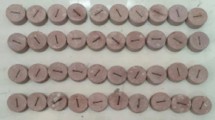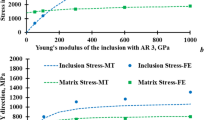Abstract
An analytical model is presented to predict the temperature field induced in a fractured solid by mechanical loadings. The heat conduction equation used to compute the temperature field consists of three separate terms that account for the coupling effects. These are the thermoelastic, thermoplastic and thermofracture coupling terms. Finite element formulations were used for the numerical solutions of a case study. This case study involved experimental assessments of temperature rises near the tip of a stationary crack when subjected to an impact load that attempted to open the crack surfaces. Good correlations of analytical and experimental results were obtained. The measurable temperature rises in a fractured solid suggested that the coupling effect may be significant enough to influence the fracture characteristics of a solid; in particular, if the bulk temperature of the solid is close to the transition temperature from the brittle to ductile fracture mode or vice versa.
Similar content being viewed by others
References
K.Schonert and R.Weichert, Chemie Ingenieur Technik 41 (1969) 295.
P.G.Fox and J.Soria-Ruiz, Proceedings, Royal Society London A 317 (1970) 79–90.
R.Weichert and K.Schonert, Journal of the Mechanics and Physics of Solids 22 (1974) 127–133.
R.Weichert and K.Schonert, Journal of the Mechanics and Physics of Solids 26 (1978) 151–161.
G.T.Hahn, R.G.Hoagland, A.R.Rosenfield and R.Sejnoha, Metallurgical Transactions 5 (1974) 475–482.
K.N.G.Fuller, P.G.Fox and J.E.Field, Proceedings, Royal Society, London A 341 (1975) 537–557.
J.T. Norris, Undergraduate Honors Thesis, Union College, Department of Mechanical Engineering, Schenectady, N.Y. (1976).
A. Kobayashi and H. Suemasu, in Composite Materials, K. Kawata and T. Akasaka (eds.), Proceedings Japan-U.S. Conference, Tokyo (1981) 339–346.
Peter J.Loose and F.R.Brotzen, Metallurgical Transactions A 14A (1983) 1409–1419.
J.D.Bryant, D.D.Makel and H.G.F.Wilsdorf, Materials Science and Engineering 77 (1986) 85–93.
K.Sano, Journal of the Iron and Steel Institute of Japan, 77:2 (Feb. 1987) 380–386 (in Japanese).
T.R.Hsu, The Finite Element Method in Thermomechanics, George Allen and Unwin Ltd., London (1986).
A.Banas, T.R.Hsu and N.S.Sun, Journal of Thermal Stresses 10 (1987) 319–344.
J.R.Rice and N.Levy, in the Physics of Strength and Plasticity, A.S.Argon (ed.) MIT Press, Cambridge, MA (1969) 277.
Z.B.Kuang and S.N.Atluri, Journal of Applied Mechanics 52 (1985) 274–280.
S.N.Atluri, M.Nakagaki et al., Engineering Fracture Mechanics 23, No. 1 (1986) 167–182.
N. Sun, ‘The Analysis of the Thermomechanical Coupling Effect on Fractured Solid by the Finite Element Method’, Ph. D. dissertation, Department of Mechanical Engineering, University of Manitoba, Winnipeg, Canada (1991).
J.R.Rice, Journal of the Mechanics and Physics of Solids 26 (1978) 61–78.
J.D.Landes and J.A.Begley, in Post-yield Fracture Mechanics, D.G.H.Latzko (ed.) Applied Science Publishers Ltd., London (1979) 211–253.
J.W.Dally, W.L.Fourney and G.R.Irwin, International Journal of Fracture 27 (1985) 159–168.
M.F.Kanninen and C.H.Popelar, Advanced Fracture Mechanics, Oxford University Press, New York (1985).
L.Y.Chao, D.Singh and D.K.Shetty, Journal of Engineering for Gas Turbines and Power 111 (Jan. 1989) 168–173.
K.J.Bathe, Finite Element Procedures in Engineering Analysis, Prentice-Hall, Englewood Clifs, N. J. (1982).
O.C.Zienkiewicz, The Finite Element Method 3rd edn., McGraw-Hill, London (1977).
Thomas J. R.Hughes, The Finite Element Method, Prentice-Hall, New Jersey (1987) Ch. 4–6.
V.I.Krylov, Approximate Calculation of Integrals, McMillar Co., N. Y. (1962) Ch. 7.
Carl-Erik Froberg, Numerical Mathematics—Theory and Computer Applications, The Benjamin Inc. (1985) Ch. 5.
C.F.Osgood and O.Shisha, Journal of Approximation Theory 17 (1976) 150–165.
D.E. McCabe, Fracture Toughness Evaluation by R-Curve Methods, ASTM STP 527 (1973).
D.Broek, Engineering Fracture Mechanics 5 (1975) 45–53.
D.Broek, ‘The Residual Strength of Aluminium Sheet Alloy Specimens Containing Fatigue Cracks or Saw Cuts’, Tech. Rept. NRL-TRM. 2143, National Aerospace Laboratory, Amsterdam (1965).
D.Y. Wang and D.E. McCabe, ‘Investigation of R-curve Using Comparative Tests with CCT and CLWL Specimens,’ Presented at Eighth National Fracture Symposium, Brown University, August (1974).
AyaldesJayatilaka, Fracture of Engineering Brittle Materials, Applied Science Publishers Ltd, London, UK (1979).
J.L.Nowinski, Theory of Thermoelasticity with Appreciation, European Printing Cooperation, Ireland (1978).
D. Rosenthat, Transactions of the ASME (1946) 849–866.
W.A. Logsdon, Mechanics of Crack Growth, ASTM STP 590 (1976) 43–60.
A.M. Sullivan, C.N. Freed and J. Stoop, Fracture Toughness Evaluation by R-Curve Methods, ASTM STP 527 (1973) 85–104.
W.H. Cubbe, P.M. Unterweisei and C.W. Kirkpatrick, Metal Handbook, 9th edn., vol. 1, ASM (1978).
J.E.Bailey, The Philosophical Magazine 8 (1963) 223.
J.M. Barsom and S.T. Rolfe, in Impact Testing of Metals, ASTM STP 466 (1970) 281–302.
S.T.Rolfe and J.M.Barsom, Fracture and Fatigue Control in Structures: Applications of Fracture Mechanics, Prentice-Hall, Englewood Cliffs, New Jersey (1977) Ch. 4.
J.R.Klepaczko, Journal of Engineering Mathematics and Technology 104 (1982) 29–35.
Author information
Authors and Affiliations
Rights and permissions
About this article
Cite this article
Sun, N.S., Hsu, T.R. Thermomechanical coupling effects on fractured solids. Int J Fract 78, 67–87 (1996). https://doi.org/10.1007/BF00018501
Received:
Accepted:
Issue Date:
DOI: https://doi.org/10.1007/BF00018501




